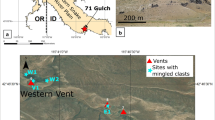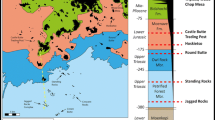Abstract
Submarine explosive eruptions are generally considered to become less likely with increasing depth due to the increasing hydrostatic pressure of the overlying water column. Volcaniclastic deposits from the North Arch volcanic field, north of Oahu, have textural characteristics of explosive fragmentation yet were erupted in water depths greater than 4,200 m.
The most abundant volcaniclastic samples from North Arch are clast-supported with highly vesicular, angular pyroclasts. They are most likely near-vent pyroclastic fall deposits formed in eruption columns of limited height. Interbedded with highly vesicular pillow lava, they form low (50 to 200 m), steep-sided cones around the vents. Less common are stratified samples with graded bedding; one such sample includes a layer of roughly aligned, platy, bubble-wall glass fragments (resembling littoral limu o Pele) that may have been deposited by density currents. In addition to bubble-wall glass shards, numerous glass fragments with spherical, delicate spindle and ribbon shapes, and Pele's hair-like glass strands occur in the finer size fraction (<0.5 mm) of some samples. They are probably more distal fallout. Another sample, consisting of glass fragments dispersed in a marine clay matrix, was apparently reworked and deposited farther from the vents by bottom currents.
Glass compositions include low-(∼0.4-0.6 wt%) and medium-K2O (>0.6 wt%) alkalic basalt, basanite, and nephelinite. Sulfur and chlorine abundances are high, reaching a maximum of 1,800 and 1,300 ppm, respectively. The ubiquitous presence of limu o Pele fragments, regardless of glass composition, suggests that bursts of Strombolian-like activity accompanied most eruptions. Coalescing vesicles observed in larger pyroclasts and some pillow lava suggests accumulation of volatiles. Since the great hydrostatic pressure makes steam expansion impossible, a volatile-rich, supercritical magmatic fluid probably drove the eruptions. If these volatile-rich magmas had erupted in shallow water or subaerially, tall fountains would most likely have resulted. The great hydrostatic pressure (>40 MPa) limited fountain and eruption column heights.









Similar content being viewed by others
References
Bischoff JL, Rosenbauer RJ (1988) An empirical equation of state for hydrothermal seawater. Am J Sci 285:725–763
Cas RAF, Wright JV (1987) Volcanic successions, modern and ancient. Allen and Unwin, London, pp 1–528
Clague DA (1987) Hawaiian xenolith populations, magma supply rates, and development of magma chambers. Bull Volcanol 49:577–587
Clague DA, Dalrymple GB (1988) Age and petrology of alkalic postshield and rejuvenated stage lava from Kauai, Hawaii. Contrib Mineral Petrol 99:202–218
Clague DA, Davis AS, Bischoff JL, Dixon JE, Guyer R (2000) Lava bubble-wall fragments formed by submarine hydrovolcanic explosions on Loihi Seamount and Kilauea Volcano. Bull Volcanol 61:437–449
Clague DA, Frey FA (1982) Petrology and trace-element geochemistry of the Honolulu Volcanics, Oahu: implications for the oceanic mantle beneath Hawaii. J Petrol 23:447–504
Clague DA, Holcomb RT, Sinton JM, Detrick RS, Torresan ME (1990) Pliocene and Pleistocene alkalic flood basalts on the seafloor north of the Hawaiian Islands. Earth Planet Sci Lett 98:175–191
Clague DA, Uto K, Satake K, Davis AS (2002) Eruption style and flow emplacement in the submarine North Arch volcanic field, Hawaii. In: Takahashi E, Lipman PW, Garcia MO, Naka J, Aramaki S (eds) Hawaiian volcanoes: deep underwater perspectives. Am Geophys Union Monogr 128:65–84
Clague DA, Batiza R, Head JW III, Davis AS (2003a) Pyroclastic and hydroclastic deposits on Loihi Seamount, Hawaii. In: White JD, Smellie J, Clague DA (eds) Explosive subaqueous volcanism. Am Geophys Union Monogr 140:73–95
Clague DA, Davis AS, Dixon JE (2003b) Submarine Strombolian eruptions on the Gorda Mid-Ocean Ridge. In: White JD, Smellie J, Clague DA (eds) Explosive subaqueous volcanism. Am Geophys Union Monogr 140:111–128
Davis AS, Clague DA (2003) Hyaloclastite from Miocene seamounts offshore central California: compositions, eruption styles, and depositional processes, In: White JD, Smellie J, Clague DA (eds) Explosive subaqueous volcanism. Am Geophys Union Monogr 140:129–142
Davis AS, Clague DA, Friesen WB (1994) Petrology and mineral chemistry of basalt from the Escanaba Trough, southern Gorda Ridge. US Geol Surv Bull 2022:153–170
Davis AS, Clague DA, Bohrson WA, Dalrymple GB, Greene HG (2002) Seamounts at the continental margin of California: a different kind of oceanic volcanism. Geol Soc Am Bull 114:316–333
Dixon JE, Clague DA, Wallace P, Poreda R (1997) Volatiles in alkalic basalts from the North Arch volcanic field, Hawaii: extensive degassing of deep submarine-erupted alkalic series lavas. J Petrol 38:911–939
Eissen J-P, Fouquet Y, Hardy D, Ondreas H (2003) Recent MORB volcaniclastic explosive deposits formed between 500 and 1,750 m.b.s.l at the axis of the Mid-Atlantic Ridge. In: White JD, Smellie J, Clague DA (eds) Explosive subaqueous volcanism. Am Geophys Union Monogr 140:143–1408
Fisher RV (1961) Proposed classification of volcaniclastic sediments and rocks. Geol Soc Am Bull 72:1395–333
Fisher RV, Schmincke H-U (1984) Pyroclastic rocks. Springer, Berlin, Heidelberg New York, pp 1–472
Fouquet Y, Eissen JP, Ondréas H, Barriga F, Batiza R, Danyushevsky L (1998) Extensive volcaniclastic deposits at the Mid-Atlantic Ridge axis: results of deep-water basaltic explosive activity? Terra Nova 10:280–286
Frey FA, Clague DA, Mahoney JJ, Sinton JM (2000) Volcanism at the edge of the Hawaiian Plume: petrogenesis of submarine alkalic lavas from the North Arch volcanic field. J Petrol 41:667–691
Gill J, Torssander P, LaPierre H, Taylor R, Kaiho K, Koyama M, Kusakabe M, Aitchison J, Cisowski S, Dadey K, Fujioka K, Klaus A, Lovell M, Marsaglia K, Pezard P, Taylor B, Tazaki K (1990) Explosive deep water basalt in the Sumisu backarc rift. Science 248:1214–1217
Head JW, Wilson L (2003) Deep submarine pyroclastic eruptions: theory and predicted landforms and deposits. J Volcanol Geotherm Res 121:155–193
Hékinian R, Pineau F, Shilobreeva S, Bideau D, Gracia E, Javoy M (2000) Deep sea explosive activity on the Mid-Atlantic Ridge near 34°50′ N: Magma composition, vesicularity and volatile content. J Volcanol Geotherm Res 98:49–77
Hon K, Heiker C, Kjargaard JI (1988) Limu o Pele: a new kind of hydroclastic tephra from Kilauea Volcano, Hawaii. Geol Soc Am Abst Prog 20 (7):112–113
Maaloe S, James D, Smedley P, Petersen S, Garmann LB (1992) The Koloa volcanic suite of Kauai, Hawaii. J Petrol 33:761–784
Maicher D, White JL (2001) The formation of deep-sea Limu o Pele. Bull Volcanol 63:482–496
Mattox TN, Mangan M (1997) Littoral hydrovolcanic explosions: a case study of lava-seawater interaction at Kilauea volcano. J Volcanol Geotherm Res 75:1–17
Moore JG, Schilling JG (1973) Vesicles, water, and sulfur in Reykjanes ridge basalts. Contrib Mineral Petrol 4:105–118
Parfitt EA (2004) A discussion of the mechanisms of explosive basaltic eruptions. J Volcanol Geotherm Res 134:77–107
Peng D-Y, Robinson DB (1979) The calculation of three-phase solid-liquid-vapor equilibrium using an equation of state. Advances in chemistry series 182, Am Chem Soc, Washington, DC, pp 185–196
Reiners PW, Nelson BK (1998) Temporal-compositional-isotopic trends in rejuvenated-stage magmas of Kauai, Hawaii, and implications for mantle melting processes. Geochim Cosmochim Acta 62:2347–1368
Reiners PW, Nelson BK, Izuka SK (1999) Structural and petrologic evolution of the Lihue Basin and eastern Kauai, Hawaii. Geol Soc Am Bull 111:674–685
Staudigel H, Schmincke H-U (1984) The Pliocene seamount series of La Palma (Canary Islands). J Geophys Res 89:11195–11215
Vergniolle S, Mangan M (2000) Hawaiian and Strombolian eruptions. In Sigurdsson H, Houghton BF, McNutt S, Rymer H, Stix J (eds) Encyclopedia of volcanoes. Academic Press, San Diego, pp 447–461
Wohletz KH (1983) Mechanism of hydrovolcanic pyroclast formation: grain size, scanning electron microscopy, and experimental studies. J Volcanol Geotherm Res 17:31–36
Wohletz KH (2003) Water/ magma interaction: physical consideration for the deep submarine environment. In: White JD, Smellie J, Clague DA (eds) Explosive subaqueous volcanism. Am Geophys Union Monogr 140:25–49
Yang H-J, Frey FA, Clague DA (2003) Constraints on the source components of lavas forming the Hawaiian North Arch and Honolulu Volcanics. J Petrol 44:603–627
Zimanowski B, Buettner R, Lorenz V, Haefele H-G (1997) Fragmentation of basaltic melt in the course of explosive volcanism. J Geophys Res 102:803–814
Acknowledgments
DAC thanks JAMSTEC, particularly Eiichi Takahashi, Jiro Naka, Kozo Uto, and the Shinkai 6500 Team for support in mapping and sampling the North Arch volcanic field in 2000 and 2002. We also thank Naoto Hirano for his observations and sample selection during Shinkai dive S704 and Michelle Coombs for providing some glass analyses of the S704 flow samples. Summer intern Stella Maceri helped cut and describe some of these samples as part of a hyaloclastite study. Robert Oscarson assisted with microprobe and SEM analyses, and Jenny Paduan and Nadine Golden in producing Fig. 1 and 2. Constructive reviews by James White, Kathy Cashman, and Associate Editor Jocelyn McPhie improved the manuscript.
Author information
Authors and Affiliations
Corresponding author
Additional information
Editorial responsibility : J. McPhie
Rights and permissions
About this article
Cite this article
Davis, A.S., Clague, D.A. Volcaniclastic deposits from the North Arch volcanic field, Hawaii: explosive fragmentation of alkalic lava at abyssal depths. Bull Volcanol 68, 294–307 (2006). https://doi.org/10.1007/s00445-005-0008-7
Received:
Accepted:
Published:
Issue Date:
DOI: https://doi.org/10.1007/s00445-005-0008-7




